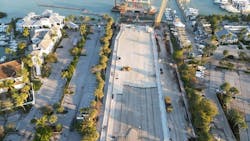Florida's U.S. 1 Bridge Making Progress
The $122 million U.S. 1 bridge over the Loxahatchee River in Jupiter, Fl. is entering its next construction phases and is on track to finish in the spring of 2026.
Walls have been construction along the bridge's piers. Next, residents will see concrete beams rise on the bridge’s approach spans, according to Scott Case, the project's senior engineer, in a statement.
Case said this week that the project is 56% complete, and that one lane in each direction remain on track to open to drivers by Nov. 9. Pedestrian and bike lanes would open as well.
Both lanes are scheduled to open for drivers next spring.
All construction activity is out of the water now, and a crew of more than 100 members is working from 7 a.m. to 8 p.m. every day, Case said. They will install steel parts of the bridge after a company in Alabama delivers them in April.
With weather impacts in mind, Johnson Bros., the Florida contractor handling the reconstruction, has been granted nine more days to finish the project in time for a cash incentive.
-------------------------------------
Source: The Palm Beach Post
